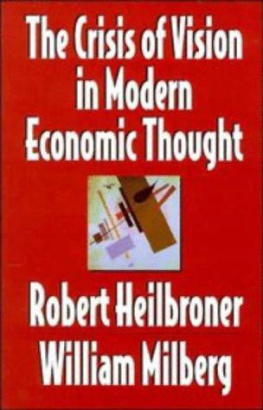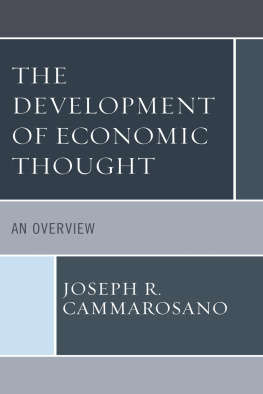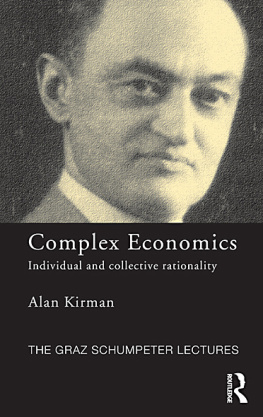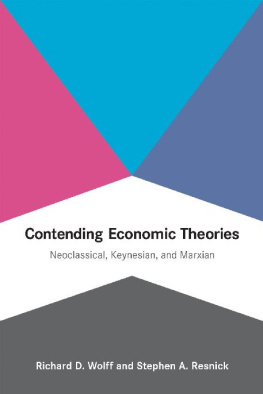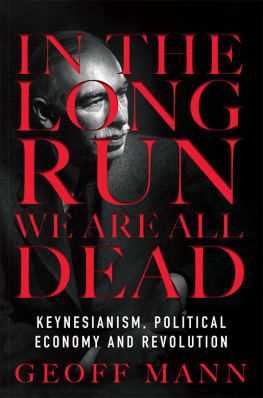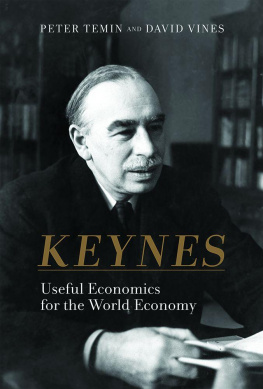| Chapter 1
What Is at Stake |
| Our intentions in writing this book are two. The first may command disagreement, but not disapproval. It is to place recent developments in macroeconomics into the context of the history of modern economic thought. This seemingly harmless pedagogical exercise, however, conceals a disturbing problem. Let us describe it in terms of the first-year graduate course in the history of economic thought that we have frequently co-taught. |
| The course covers two semesters, the first of which deals mainly with the dramatic scenarios of the Physiocrats, Smith, Ricardo, Marx, and Mill. This part of the course unfailingly captures the interest of its audience. Who can resist the appeal of these ventures in imaginative logic, in which sociological and political considerations interact with a market-constrained drive for capital to yield the varied trajectories of capitalism that the great economists foresaw? |
| The second semester begins with the formulations of Jevons, Edgeworth, and Walras. There is, initially, a sense of discontinuity as the narrower concerns of marginalism displace the broader objectives of classical thought, but the audience soon recognizes the underlying continuity of a new "chapter" in the ongoing history of economic thought. The new chapter is more finely analytical in style and less explicitly sociopolitical in content than its predecessor, but it also contains two attributes that legitimate its inclusion within the meta-narrative we call the history of economic thought. The first is an explicit concern for the relevance of its content to the "real" world. |
| | What is surprising is that the new chapter at first seems to lack this attribute. It is true that Jevons writes on the coal question and Edgeworth on the distribution of income required to accommodate the differences in the sensibilities of the various classes and the two genders, but these writings are peripheral to their central, highly abstract concerns with utility; whereas Walras, in our time the commanding figure of the movement, is quite indifferent even hostile to the practical application of general equilibrium analysis to political life, despite his own lifelong interest in questions of agrarian socialism. |
| Yet this seeming exception to our rule that regnant ideas must be relevant to lived economic experience is in fact another vindication of it. Jevons and Edgeworth are key figures in the introduction of marginal analysis to economics, but their statement of it did not actually displace the Millian center of gravity until Marshall's powerful text became its universally recognized exposition toward the end of the nineteenth century. Even more telling, the identification of Walras's name with marginalism would not become commonplace until his highly disengaged approach became a leading force in the postmarginalist, post-Marshallian, post-Keynesian era that will be a central focus of our attention in the chapters to come. |
| A second, equally important attribute lies in the presence of an identifiable central focus to the economic thought of the period. As we shall see, this focus lies not so much in the analytical framework its authors employ, or in the conclusions they reach, but in the "vision" the often unarticulated constructs from which they start. Sometimes, although not necessarily, this vision is incorporated in a seminal synthetic presentation. In the first semester this is accomplished in John Stuart Mill's Principles of Political Economy, which projects an eclectic version of classical thought that dominates the field from 1848 to 1870; in the second semester, a similar function is performed for the marginalist period by Alfred Marshall's Economics, which rules the roost from 1890 until the 1920s. |
| There follows Keynesian economics, the equivalent of the French Revolution, in the second semester. The focal point again changes, but once more, the two identifying attributes are present: Keynesian economics is quintessentially concerned with the real-world applications of its analytical content, and after a period of confusion, a consensual center emerges, for which Samuelson's Principles of Economics may be said to constitute its Millian or Marshallian text. "Keynesian economics" thereupon dominates and gives unity to the economic discourse of its era, as did "marginalism" and "classical political economy" in the eras that preceded it. This is not to claim that other economic schools could not be featured in this overall narrative, Marxian or institutional economics being obvious candidates. It is to make the point that however the chapters of the narrative are identified, they must all manifest the properties of real-world applicability and centrality of focus. |
| It is this point that sets the stage for the initial problem to which this book is addressed. It is to account for the absence of such a distinct "chapter" in the years that follow the Keynesian era let us say, roughly, the last quarter century. Thus our bland intention of finding a place for contemporary economics within the larger history of the subject turns out to be much more contentious than might have been anticipated; and leads, indeed, to the second of our larger purposes, whose argumentative character will be immediately self-evident. This is to criticize the direction of economic theorizing in America. The thrust of our criticism is already implicit in the title of our book, and now becomes explicit in the first of the attributes that we have ascribed to economics up to the post-Keynesian period namely, its continuously visible concern with the connection between theory and "reality." By way of contrast, the mark of modern-day economics is its extraordinary indifference to this problem. At its peaks, the "high theorizing" of the present period attains a degree of unreality that can be matched only by medieval scholasticism. The second purpose of our book must therefore be apparent. It is to serve as a catalyst for change with respect to that attitude. |
| The Archimedean point to which we shall direct our criticism has already been announced: It is the all-important function of vision for the enterprise of analysis itself. This is a matter to be explored intensively as we go along, but an initial statement seems in order. By analysis we mean the process of deducing consequences from initial conditions, of attending scrupulously to chains of reasoning, and of guarding against the always present temptation to substitute demagoguery for intellectual exchange. By vision we mean the political hopes and fears, social stereotypes, and value judgments all unarticulated, as we have said that infuse all social thought, not through their illegal entry into an otherwise pristine realm, but as psychological, perhaps existential, necessities. Together vision and analysis form the basis of everything we believe we know, above all in that restricted but extremely important area of knowledge in which we seek to understand, and where possible to change, the terms and conditions of our collective lives. This is the area to which economic investigation directs its efforts and, accordingly, to which our own critique will be directed. |
|
|

